There's a lot of hype right now for the animated film adaptation of "Batman: The Killing Joke", and why wouldn't there be? It brings back the iconic voices of Kevin Conroy and Mark Hamill, and it's based on the quintessential Joker story. One of the aspects of that story was that it showed the Joker's possible origin, who he was before and how he became the Clown Prince of Crime. It's seen by many as the character's definitive origin, but that didn't stop someone from trying to put their own spin on it.
Back in 2006, DC had cancelled its anthology Batman title "Legends of the Dark Knight" after nearly 20 years and over 200 issues in favor of a new series, "Batman Confidential". To try and put importance on the book, it was billed as telling in-continuity pivotal moments in Batman's career. Some stories included his first meeting with Lex Luthor, the return of one-time villain the Wrath, and the first and I believe only comic appearance of 60's Batman TV show villain King Tut. At #31 though, they dropped the importance aspect for just whatever story the writer wanted to tell, much like "Legends" did. It was here that my interest in the book began to waver and I dropped it shorty before its final arc and cancellation at #54.
But right now, we're taking a look at the book's second story, "Lovers and Madmen", which retold Batman's first meeting with the man who would become the Joker...in a story that would not be referenced in any other Batman story since then. But does that really mean that it sucks? Having not read the story in about 8 years, let's dive in, see whether my feelings have changed and how it stacks up against "The Killing Joke".
I don't usually talk about the individual issue covers, but I'm making an exception for this story because the covers and interior art from Denys Cowan was talked about a lot when this story was coming out.
The cover for part one isn't too bad, showing Batman chasing Jack down an alley way. As you'll see later on, this is actually the best cover out of all the others from this arc.
The issue itself with Batman, 42 weeks into his career, reflecting on how he's learned and adapted in his war on crime, realizing that criminals are creatures of habit and how to take them on, and that the streets are becoming peaceful. There's a couple panels that are worth mentioning. There's one of Batman wearing a costume with the yellow oval symbol on his chest with a caption box "I learned what was silly". It seems that the writer Michael Green was putting his personal opinions in the story. I know people have personal preferences when it comes to Batman's suit, but you shouldn't try to have the characters have those reflections, especially when said "silly" design is what a majority of people are familiar with it and is probably what comes to mind when they think of Batman. Another panel is Batman looking over a table of weapons talking about what was useful and what would slow him down. There's a few odd choices like nunchucks, a sai, and even a freaking mace. The mace really makes me scratch my head, because one, that's a pretty lethal weapon, and two, how would that fit in the utility belt?
Feeling chippy, Bruce decides to celebrate by going to an exhibit at the Gotham Museum where he meets Bruce Love Interest #539, museum curator Lorna Shore. I kid of course, but seriously, unless your name is Selina or Talia, you're probably not going to leave an impact on Batman lore.
Later on, Batman arrives to an apparent robbery at a jewelry store where the owner and his two sons are killed, but nothing is stolen. Batman researches in depth why someone would want to murder these people but comes up with nothing. And that's when we cut to a bar where we meet the perpetrator of this crime, Jack. He's first mentioned when the bartender tells the waitress "Get that joker out of here." That's kind of subtle foreshadowing I'd expect from "Gotham" (and I checked, Michael Green is actually a producer on the show, so that might explain a lot). The waitress begins talking with Jack and we learn that while Jack's very good at what he does, it's become to easy for him and he's bored, which is why he left the jewelry store without taking anything. The waitress tells Jack that he should he should give it another shot to see if anything changes for him, and he agrees. I didn't realize it until someone pointed it out, but the waitress is actually Harleen Quinzel, still a college student.
Jack helps a gang break into a bank, but he's still bored, so he kicks over a gumball machine to trip the security, leading to a shoot-out with the police. Jack runs into a security guard and hands him a gun, wanting him to shoot him. But then Jack notices that Batman arrives taking out his compatriots. "What's this? Look at him. That costume...Those toys he jangles around...Yet he's as serious as serious can be." And the final panel of the issue is Jack cracking a smile saying "He looks...ridiculous."
It's not a bad ending, showing that Batman's presence is that catalyst that puts Jack on his path to being the Joker.
The cover to part two is okay, but it's the beginning of the degradation of the cover art. The concept is simple with Batman standing prepared to fight with Jack's shadow over her, but I have to wonder if that's blood he's standing in. Where the heck is he? Also, the proportions of his body are kind of off, with his eyes being too far spaced.
The issue opens with Batman standing over the guard that Jack wanted to shoot him killed, with a note left for Batman saying "THANKS YOU MADE MY DAY". Jack then goes on a crime spree, committing unusual crimes with no rhyme or reason, all to get Batman's attention while also leaving Gotham in a panic. A frustrated Bruce gets a lead through a crime boss named Maletesta, who Jack was working for on the bank job before he screwed it up. Wanting to get his hands on Jack too, Maletesta tells Batman to let him know if he needs any help taking care of Jack. Taking a break from the case for a moment, Bruce goes to see Lorna, and the two sleep together, Bruce commenting that he feels at peace for the first time since his parents died. This is a nice moment, but we do actually see the two in bed together with the sheets barely covering them and they just look awkward in the position they're drawn in.
Bruce returns to find the newly completed Bat-Computer putting together a list of potential targets Jack may strike. The most likely target is a charity function at the Gotham Museum where Lorna works.
Not much to comment on in this issue. It's cool to see Batman becoming frustrated with the new kind of criminal he's seeing in Jack after believing he'd figured out how everything works. The stuff with Lorna was okay, but I think they pushed it too far by actually showing them in bed. I'm not a prude or anything, but it's just how it was drawn that made me feel uncomfortable.
Part three's cover is definitely the worst of the bunch. It's just really dirty, with lines and shadows drawn needlessly. But something's definitely up with Batman's face. I mean, his mouth looks like a stop-motion mouth placed in the wrong place. And what's going on with his left eye? Not only is it a little spaced out too far from the right, even more that the last cover, but it looks like his brow grew out and the eye is getting sucked into his head. Much like the cover, it's here that the art for the story starts to go downhill.
The issue begins with Jack and some other guys he hired crashing into the museum and shooting it up. Batman arrives, just as Jack was hoping for, and makes quick work of the goons. He turns his attention to Jack, who takes a hostage, and out of everyone there, who does he grab? Yep, Lorna. What are the freaking odds? With Jack holding her at gunpoint, Batman grabs one of the goons' guns and shoots Jack's gun out of his hand. While Batman himself admits that he hates guns, and is obviously not part of his arsenal, I think it's a good idea that he knows how to use one, like the situation called for here. Jack then pulls out a knife and stabs Lorna, leaving Batman to tend to her as Jack escapes, but not before getting his face scarred by a batarang.
Lorna is taken to the hospital and is critical condition, the doctors fearing the worst. Bruce tries to figure out his next move, going to see Jonathan Crane to make a psychological profile of Jack, Crane telling him that he's dealing with something more than crime or a single man, but insanity and evil. Not seeing any other options but unwilling to do it himself, Bruce calls Maletesta and tells him where Jack is, based on the Bat-Computer's possibilities of where Jack would go to fix his face, wanting Maletesta to do what he wants with Jack.
Let's talk about Batman's no-kill rule for a second. I won't pretend that he didn't kill in his first appearances, but it did eventually become a main part of the character. The movies have played fast and loose with this though. Keaton's Batman was a straight-up murderer on several occasions and I still contest that Affleck's Batman didn't set out to kill anyone and that any deaths that happened were indirect. But Bale's Batman did have a clear no-kill rule (ignoring that him allowing Ra's to die could be considered murder). At the time this story came out, "The Dark Knight" was still being made and the hype was building. In that movie itself, Bruce believed that the only way to stop the Joker completely would be to kill him, but he never did anything like Bruce is doing in this story. Bruce would have rather revealed his identity to the public than bring himself to kill the Joker. Yes, Bruce in this story is still young, but so he was he also in "The Dark Knight". Even if Batman does think killing as an option, he quickly disregards those thoughts.
The idea for part four's cover is actually a good one, with Joker emerging from the first time out of the chemicals that bleached his skin. The execution in this case, however, is pretty poor. Once again, the distance between eyes is too far and they're heavily black aside from the green pupils. He's also squinting where you would expect his eyes to be widened. Also, it looks like he's supposed to be smiling, but that can be attributed to the scars given to him from the previous issue, so I think he's actually scowling.
The art of this issue is pretty much the worst of all the issues, with disproportionate bodies, ugly imagery when it shouldn't be, not to mention a problem that began in the previous issue, lazy eyes (like one eye is veering off in the other direction than the other is).
Maletesta and some goons grab up Jack and take him to an abandoned pharmaceutical factory where they want to slowly kill him. They begin to beat him pretty bad, but Jack just criticizing their technique, like that they keep focusing on the face when it's already pretty beaten. I do kind of like that in the middle of a beatdown, Joker would criticize how it was being done. Jack manages to get the upper hand on them, but an ensuing fight where Maletesta and most of his goons are killed (save for one that Jack lets go because he suggested that they just shoot him) leads to a left-over vat of anti-psychotics to spill out, quickly filling up the room, with Jack in danger of drowning. Jack manages to find a vent that he swims through, escaping through a drain that leads him outside, where he emerges to find his skin bleached. He begins to laugh, thinking it's a joke.
Batman, who had realized his mistake and wanted to stop Maletesta from killing Jack, arrives too late and sees what Jack has become, asking himself "What have I done?"
The art aside, what I really liked about this issue was Jack's transformation into the Joker, and "Bunny on the Moon" bit is one of my favorite aspects of the story, just adding another crazy element to the Joker's unstable mind.
The cover to part five isn't too impressive with Joker just standing there apparently making his grand debut. Unfortunately, like the previous cover, the Joker's face is all wrong. His left eye is apparently much more to the side than a normal face, and his eyes are much smaller than you'd expect, squinting again rather than widened. And then there's the smile. That's supposed to be his most prominent feature but you have to get really close to tell that he actually is smiling.
This is where I think the story picks up, as we finally have Jack looking like the Joker, but the art is a little improved too, and even if there is some distortion, I think it fits with the Joker's warped mind.
The issue itself begins with Batman trying to chase Joker outside the factor, but loses him, believing that what he saw was a ghost. Bruce returns home to receive news that Lorna is alive and will make a full recovery. It's not exactly explained why or how she made such a change in condition, but let's just roll with it. Bruce goes to the hospital to see her still sleeping, promising not to leave her side until she awakes.
So while the Bat's away, the Joker will play. Wanting others to see the bunny on the moon like he did as well as get Batman's attention, he decides to step it up. He apparently has a lot of money because not only does he pay off Harleen's tuition, but he gets a huge decked out blimp flying over Gotham, having it explode with shards of glass falling to the streets, killing people and leaving them with big smiles on their faces. Despite a successful plan, Joker is disappointed that Batman does not make an appearance. Bruce is still by Lorna's side when Alfred arrives to inform him what happened. Bruce refuses to leave, but Alfred leaves his Bat-gear in case he changes his mind.
After this is probably not only one of my favorite parts of the book, but one of my favorite Joker moments all together when he pretends to be a clown at the circus.
What else can you say, but "disturbing". Just those last lines alone make this one of the most sadistic Joker scenes I've seen.
A news report following this scene describes hysteria erupted and that Batman didn't appear, angering Joker enough to smash his TV, questioning why Batman isn't going after him, even after Joker has rounded all the other criminals in Gotham "so he has no one to playtime with" but him. When he wonder if Batman cares, one of the Maletesta's men that Joker has strung up tells him that Batman actually wanted him dead, which makes Joker enthusiastic and sees that as a sign that Batman really does care, thanking the man with a spray of Joker gas.
Back at the hospital, Alfred is apparently fed up with Bruce's crap about standing by while the city is terrorized when, as Alfred bluntly and so rightly puts it, "You did this." I'm totally with Alfred on this one, as Batman's characterization is way off in certain areas of the book, from wanting Maletesta to kill Jack (even though he changed his mind too late) to staying by Lorna's side (well intentioned as it may be) instead of going after Joker. After seeing the Bat-Signal outside, Bruce suits up and heads to Gordon, but is greeted instead by the Joker, leading into the final issue of this story.
The cover to the finale is rather generic, with Joker and Batman facing off just inches away from each other. The art itself isn't really appearling, especially with Joker. Does Cowan have something against showing Joker's eyes? In this cover, I don't even think they're open. As menacing as Joker's smile is, it's the manic shown in the eyes that really seals the deal. And I'm no dentist, but I don't think people have that many teeth, and I'm talking about both characters here.
The issue starts the action rather quick with Joker coming at Batman with a knife and the two scuffling. Joker then pulls out a gun and fires, but where Batman thinks he misses, he turns around to see someone hanging upside down from a nearby building and Joker had shot the rope, beginning to snap. Batman races to save him, crashing into nearby window. Batman looks back outside to find even more hostages (15 by my count) hanging upside down with Joker firing off round after round at the ropes, taunting Batman that he can't save them. After a brief moment of shock at such insanity and evil, Batman shakes it off and catches as many people as he can. Joker becomes bored and decides to just blow the building up instead. Joker laughs as Batman arrives to beat him down. Joker thanks Batman for creating him, followed by a good dialogue between the two.
BATMAN: "All those lives. All those people--you MURDERED them! Why do you kill them?"
JOKER: "Why do you SAVE them?"
BATMAN: "Because LIFE matters."
JOKER: "ALL life? Even MINE? Well in THAT case..."
Joker then throws himself off the building ledge, laughing as he falls. Batman contemplates what to do, knowing that letting him die would save so many more lives in the future, but that even though it would be indirect, he would see Joker's death here as murder on his hands, so he saves him, handing him over to Gordon's custody. Back when this story was coming out and "The Dark Knight" was being hyped, I had hoped that this scene would be used in some way in the film. And while it does feature Batman saving Joker from falling to his death, that conversation about whether Joker's life matters as much as anyone's would have been a nice touch.
Gordon then informs Batman that the woman Jack/Joker stabbed at the museum (Lorna) had regained consciousness. Bruce goes to see Lorna, but lies to her about this being the first time he's come to see her and that he's not looking for anything serious, breaking her heart. Bruce's rationale is that he can't be Batman and have someone to love, especially with new enemies like the Joker popping up, which makes sense. The problem though is that Lorna, like many of Bruce's love interests, was a one-off character and I didn't really feel anything for their break-up.
After that we find that the Wayne Foundation has made a generous donation to Jonathan Crane's reopening and renovation of Arkham Asylum, with Joker being its first inmate. In his cell, Joker "talks" to Batman, telling him that with him around, he'll never be alone. (Joker: "I know you can hear me.") Batman is indeed nearby though with a thought caption reading "I can" as the story ends.
My thoughts on the story are rather unchanged from when I first read it years ago, although I did dig a little deeper this time. The art is all over the place, sometimes being good but also being twisted in moments that call for it and others that don't. The thing is though I don't think Denys Cowan is a bad artist, as he recently did the "Batman & Robin" tie-in for DC's "Convergence" event and the art was okay there. "Lovers and Madmen" was probably a case of having to rush it out to meet the monthly schedule.
As for the story itself, it's okay, starting out strong, kind of losing ground in the middle, but picks up again as it ends with the Joker fully suited up. But in a weird way, despite some moments I really liked, it doesn't feel like the Joker we would later see following this intended-to-be in-continuity story. We see Jack is crazy before his dip into the chemicals makes him slightly more crazy. It's kind of a problem I had with Joker in the 1989 film too (not to mention it seemed to be just Jack Nicholson in make-up). What "The Killing Joke" got right was showing that the Joker is just that: the Joker. It doesn't matter who he was before, because he pushed that person deep down inside as insanity and an obsession with Batman took over his life.
I think maybe what may have made this story a little better is if they rearranged some parts:
Jack trips the security at the bank, gets taken to the abandoned factory to get beat up, where Batman tracks them, and an ensuing battle causes Jack to become Joker, and he begins a crime spree all to get Batman's attention. He stabs Lorna at the museum causing Bruce to stay by her side as Joker ups his game, leading to the final confrontation between the two. This way, it becomes another option in Joker's "multiple choice past" as well as deliver a new first confrontation between the two without Batman knowing who Joker was beforehand.
Overall, despite the weird artwork at times, "Batman: Lovers and Madmen" is worth a read if you treat it as its own story and not worry about fitting it with other tales. As a Joker story, I think whether you like the character to have an origin or not may depend on your enjoyment. Who knows? Maybe by the end of reading it, you'll be able to see the bunny on the moon too.
STORY RATING: 6/10
RECOMMENDATION RATING: 5/10
Next week, we travel to Marvel Earth-90214 for some gun-toting and web-slinging action.
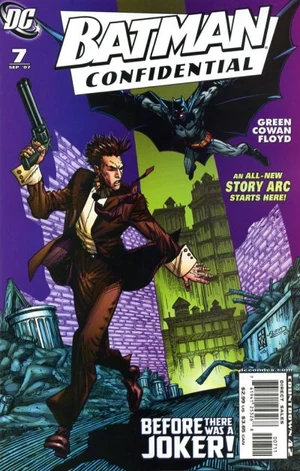
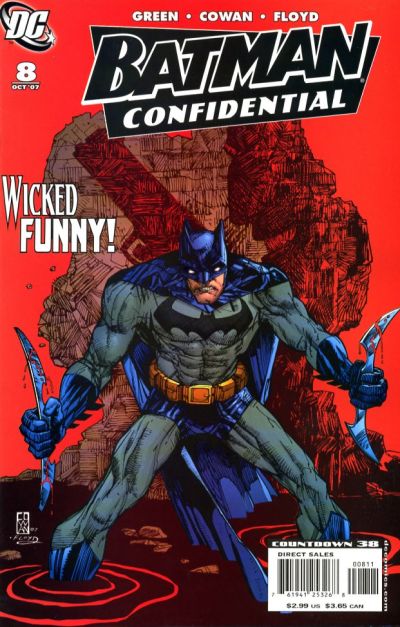
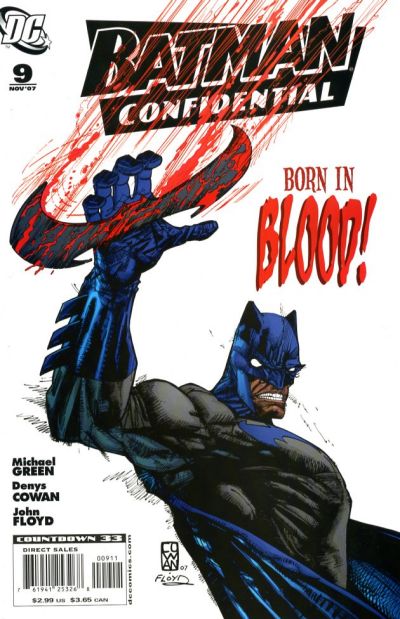
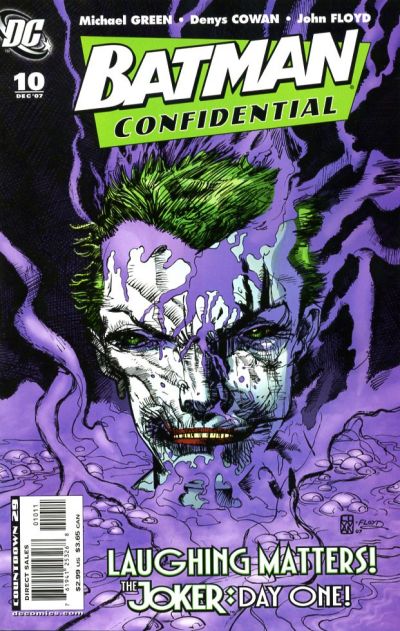

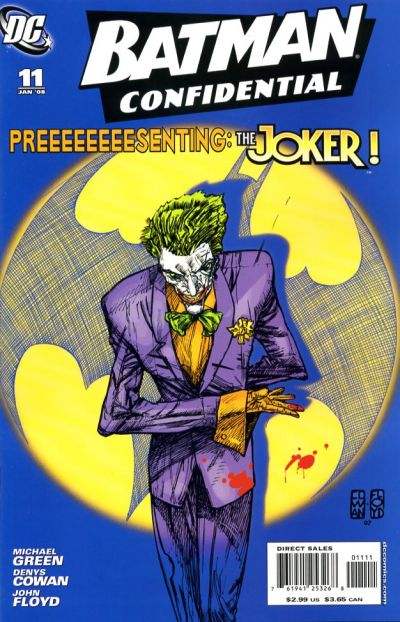

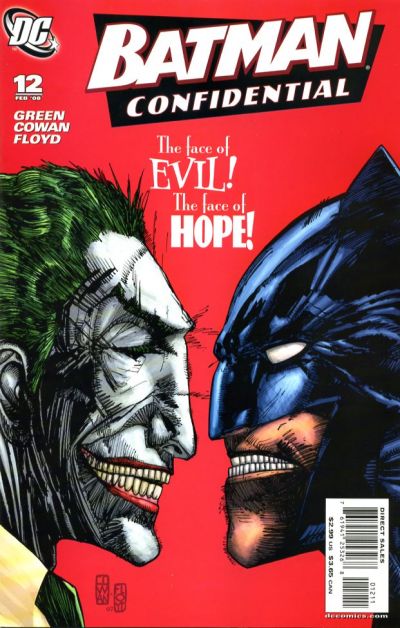
No comments:
Post a Comment